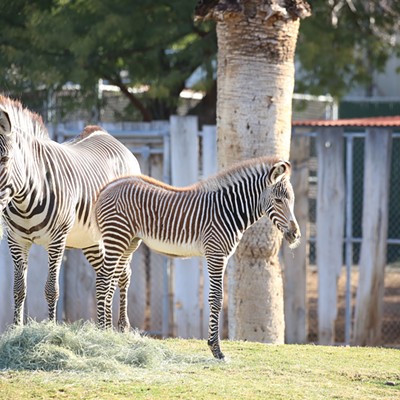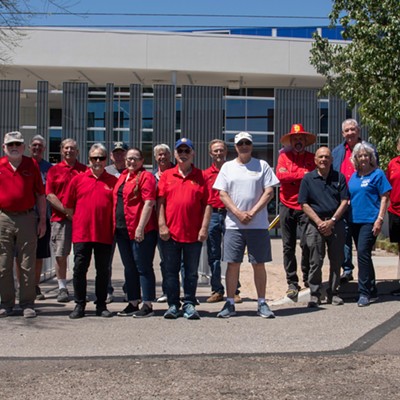1990
Jeff Smith goes on a road trip with his son, Caleb:
Caleb and I spent one month preparing for two weeks on the road, on the bike. That's about a standard ratio: two hours, days, weeks, months of prep for every corresponding unit of time on the road. This is true because bikes get their tails twisted a lot harder than cars do and therefore break more often. Even the legendary Teutonic BMW.
And so you plan for every contingency along the way and try to pack a little something as proof against it.
Caleb and I did all of this and checked it twice, finally taking off at the crack of 11 a.m. one Sunday morning. Two hours later we were riding through a monsoon downpour, soaked to the skin because we hadn't packed our rain suits where we could get at them in a panic. Not that it would have mattered, because I stupidly and predictably rode right into the middle of the storm before stopping to put on foul weather gear.
—"Jeff and Caleb's Excellent Adventure," Sept. 12
1991
Linda Kohanov tunes into what's happening at indie radio station KXCI:
Since it went on the air in December 1983, KXCI has housed a giant dysfunctional family of staff, volunteers and board members who have struggled with opposing visions, fiscal mismanagement and a gross lack of planning—problems that threatened the station's existence time and time again.
Despite the endless series of difficulties, these same people have exhibited an unusually high level of devotion, creativity and downright stubbornness to make it work. This week, as KXCI moves its frequency to 91.3 FM and increases its effective radiated power from a mere 3,000 watts to a respectable 5,000 watts, their pain and effort finally seem justified.
"For those of us who've been there awhile and paid our dues, this power upgrade is unbelievably exciting," says the station's top-rated announcer, David Squires, known on-air as Kidd Squidd. "We're gonna be blasting into the desert, way out there."
—"The Little Station That Could," Aug. 14
1992
Alisa Wabnik hears the Rev. John M. Fife's testimony:
He's been called hero, ex-con, cowboy, frat boy and rebel looking for a cause. An anonymous death threat three months ago labeled him the anti-Christ. Now he's moderator of the Presbyterian Church (U.S.A.), leading nearly 3 million worshippers along the road of truth and "tough gospel"—or down a rocky liberal landslide, depending on which churchgoer you ask.
The Rev. John M. Fife, pastor of the barrio-based Southside Presbyterian Church and media darling of the 1985-86 sanctuary trial, is causing no less controversy today than he was a decade ago, when he first found El Salvador on a map and starting illegally carting refugees over barbed wire fences at the border. He says he's never backed away from a challenge and doesn't plan to start now.
"I've got this neurosis," the pastor confesses. "I like to run toward problems and not away from them."
—"Tough Gospel," July 22
1993
Brian Jaramillo volleys with Arizona Daily Star sports columnist Greg Hansen:
Greg Hansen is sitting in a local coffee shop. Wearing jeans and a collared shirt, he seems relaxed and open to all questions. But he can't understand why anybody would want to read a story about him, not by him.
"I don't know why people give a shit," Hansen says.
Despite leaving an obvious trail of controversy and jilted column subjects, Hansen quickly dismisses the "controversial" label as if to say, "Who, me?"
"Strange as it seems for doing what I do, I'm not very opinionated," Hansen says with a shrug. "I just like writing information about sports."
—"Mellow Fellow," Feb. 10
1994
Jeff Smith wishes the Weekly a happy 10th birthday:
No other publisher I've worked for has put up with me as long as Doug Biggers and cheerfully taken so much shit from the reading public for running my stuff in his paper.
Of course, you'd expect me to smooth a little. After all, I've about run out of newspapers to write for, and I'm old and crippled and my mind and my eyesight are fading.
But fuck it, they don't pay me enough to kiss their asses. Besides, I didn't get to where I am today (old, crippled, stupid, unemployable and poor) by steering a prudent course. Neither did the Tucson Weekly, and that's why we're still together, and that's why I'm still having as much fun here as I did at the Arizona Daily Star back in 1968, when Larry Ferguson was my city editor and Frank Johnson was managing editor and we got to raise hell.
Because that's what a newspaper is supposed to do: raise hell and print the truth. That's what any news organization, print or electronic, is supposed to do. Look around town today and you'll find one news source that raises hell. Just one. This is it.
I love this job.
—"Speak, Memory," March 16
1995
Emil Franzi surveys legendary land speculator Don Diamond's many properties:
At the height of the British Empire, Queen Victoria could enter a room at the Foreign Office and gaze at a huge map of the entire world covered with pins indicating her extensive holdings. We suspect there's a similar room somewhere for legendary land speculator Don Diamond, featuring a big map of his Pima County empire.
Diamond owns, or owned, or influences so many things in this valley that we feel it's time to illustrate exactly how far his empire stretches—something the daily press has studiously ignored over the years. Of course, we doubt if anyone, including the U.S. government, could locate all of Diamond's vast holdings on a given day, but the following items have been selected as just a sample of how much power and influence one man can accumulate. Please remember, for the most part these are only Diamond's controversial holdings.
—"That Diamond Touch," Nov. 16













